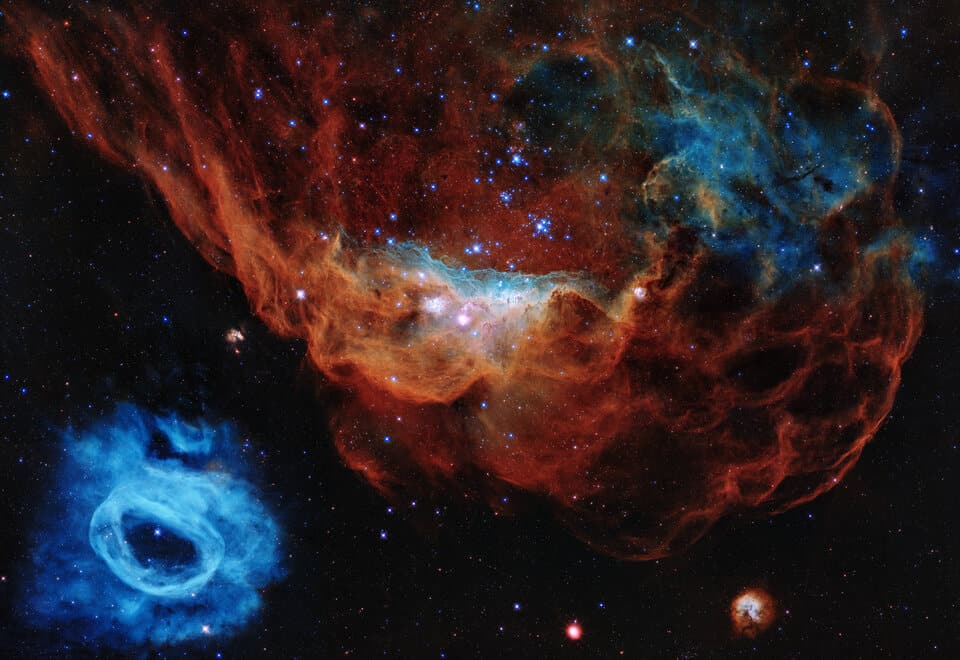Blog
Although NGC 2014 and NGC 2020 appear to be separate in this visible-light image, they are actually part of one giant star formation complex.
The star-forming regions seen here are dominated by the glow of stars at least 10 times more massive than our Sun. These stars have short lives of only a few million years, compared to the 10-billion-year lifetime of our Sun.
The sparkling centrepiece of NGC 2014 is a grouping of bright, massive stars near the centre of the image that has blown away its cocoon of hydrogen gas (coloured red) and dust in which it was born. A torrent of ultraviolet radiation from the star cluster is illuminating the landscape around it.
These massive stars also unleash fierce winds that are eroding the gas cloud above and to the right of them. The gas in these areas is less dense, making it easier for the stellar winds to blast through them, creating bubble-like structures reminiscent of coral, that have earned the nebula the nickname ‘Brain Coral’. This image is one of the most photogenic examples of the many turbulent stellar nurseries the NASA/ESA Hubble Space Telescope has observed during its 30-year lifetime. The portrait features the giant nebula NGC 2014 and its neighbour NGC 2020 which together form part of a vast star-forming region in the Large Magellanic Cloud, a satellite galaxy of the Milky Way, approximately 163 000 light-years away.

Frank Strazzeri (April 24, 1930 – May 9, 2014) was an American jazz pianist.
Strazzeri began on tenor saxophone and clarinet at age 12, then switched to piano soon after. He attended the Eastman School of Music, then took a job as a house pianist in a nightclub in Rochester in 1952. While there he accompanied visiting musicians such as Roy Eldridge and Billie Holiday. He moved to New Orleans in 1954, playing with Sharkey Bonano and Al Hirt in a Dixieland jazz setting, but his focus since then was on bebop. He played with Charlie Ventura in 1957–58 and Woody Herman in 1959 before moving to Los Angeles in 1960. There he worked extensively as a studio musician on the West Coast jazz scene, and toured with Joe Williams, Maynard Ferguson, Les Brown and Elvis Presley!(1971–74). He also played with Elvis Presley in the Aloha from Hawaii concert of 1973). He worked with Terry Gibbs, Herb Ellis, the Lighthouse All-Stars, Art Pepper, Bud Shank, Cal Tjader, Louie Bellson, and Chet Baker, in addition to recording as a leader. He died at the age of 84 on May 9, 2014.
more...Joe Henderson (April 24, 1937 – June 30, 2001) was an American jazz tenor saxophonist. In a career spanning more than four decades, Henderson played with many of the leading American players of his day and recorded for several prominent labels, including Blue Note.
Born in Lima, Ohio, Henderson was one of five sisters and nine brothers. He was encouraged by his parents Dennis and Irene (née Farley) and older brother James T. to study music. He dedicated his first album to them “for being so understanding and tolerant” during his formative years. Early musical interests included drums, piano, saxophone and composition. According to Kenny Dorham, two local piano teachers who went to school with Henderson’s brothers and sisters, Richard Patterson and Don Hurless, gave him a knowledge of the piano. He was particularly enamored of his brother’s record collection. It seems that a hometown drummer, John Jarette, advised Henderson to listen to musicians like Lester Young, Stan Getz, Dexter Gordon and Charlie Parker. He also liked Flip Phillips, Lee Konitz and the Jazz at the Philharmonic recordings. However, Parker became his greatest inspiration. His first approach to the saxophone was under the tutelage of Herbert Murphy in high school. In this period of time, he wrote several scores for the school band.
By age 18, Henderson was active on the Detroit jazz scene of the mid-1950s, playing in jam sessions with visiting New York City stars. While attending classes of flute and bass at Wayne State University, he further developed his saxophone and compositional skills under the guidance of renowned teacher Larry Teal at the Teal School of Music. In late 1959, he formed his first group. By the time he arrived at Wayne State University, he had transcribed and memorized so many Lester Young solos that his professors believed he had perfect pitch. Henderson’s college classmates included Yusef Lateef, Barry Harris and Donald Byrd. He also studied music at Kentucky State College.
more...John Arnold Griffin III (April 24, 1928 – July 25, 2008) was an American jazz tenor saxophonist. Nicknamed “the Little Giant” for his short stature and forceful playing, Griffin’s career began in the early 1940s and continued until the month of his death. At eighty, he felt no need to stop. He did not complain. He had a hard life, but often said, “as long as God has given me the gift to blow, I owe it to God to keep on blowing.” A pioneering figure in hard bop, Griffin recorded prolifically as a bandleader in addition to stints with pianist Thelonious Monk, drummer Art Blakey, in partnership with fellow tenor Eddie “Lockjaw” Davis and as a member of the Kenny Clarke/Francy Boland Big Band after he moved to Europe in the 1960s. In 1995, Griffin was awarded an Honorary Doctorate of Music from Berklee College of Music.
Griffin studied music at DuSable High School in Chicago under Walter Dyett, starting out on clarinet before moving on to oboe and then alto sax. While still at high school at the age of 15, Griffin was playing with T-Bone Walker in a band led by Walker’s brother.
Alto saxophone was still his instrument of choice when he joined Lionel Hampton‘s big band three days after his high school graduation, but Hampton encouraged him to take up the tenor, playing alongside Arnett Cobb. He first appeared on a Los Angeles recording with Hampton’s band in 1945 at the age of 17.
By mid-1947, Griffin and fellow Hampton band member Joe Morris had formed a sextet made up of local musicians, including George Freeman, where he remained for the next two years. His playing can be heard on various early Rhythm and Blues recordings for Atlantic Records. By 1951 Griffin was playing baritone saxophone in an R&B septet led by former bandmate Arnett Cobb.
After returning to Chicago from two years in the Army, Griffin began establishing a reputation as one of the premiere saxophonists in that city. Thelonious Monk enthusiastically encouraged Orrin Keepnews of Riverside Records to sign the young tenor, but before he could act Blue Note Records had signed Griffin.
He joined Art Blakey‘s Jazz Messengers in 1957, and his recordings from that time include a memorable album joining together the Messengers and Thelonious Monk. Griffin then succeeded John Coltrane as a member of Monk’s Five Spot quartet; he can be heard on the albums Thelonious in Action and Misterioso.
more...BULERIAS
Salida
Your entrance. This is how you announce yourself. “Hello, I’m coming out to dance.” The tone of your salida can be mellow or exciting, depending upon the cante and what you want to convey.
Marcaje(s)
Marking the rhythm. Here you listen and allow the cante to guide you. (If the thought of following the cante feels overwhelming, give it time, and start off by aiming to relax into your steps while staying in compás.) Mark in a way that feels good, comfortable, and fun to you. Play around with moves you know (or are currently learning) to discover this. Normally you begin with more laid back marcajes allowing the excitement to build as your dance progresses.
Paso de bulerías
The bulerías step or a more dynamic marcaje. There is the basic bulerías step (most commonly seen) along with many variations. The bulerías step builds toward the climax of your dance.
Llamada
The llamada comes toward the end or the middle of your dance. It is NOT a call for the cante to begin as you might be used to from other flamenco dances. The llamada signals that your dance is coming to a close.
Patá* (Patada)
Typically the “fanciest” part of your dance. It often involves interesting rhythmic sounds made with the feet and body. (Some people call this the desplante or refer to it as remantando la letra.)
*(A patá or pataíta por bulerías also means a full bulerías dance. Here we are just talking about one component of your dance.)
Final
Finish. This is your period (or exclamation mark). You go to corner (or the opposite direction of where you came from) to signal the finish of your dance. Always finish in the place where you began (facing away from the crowd). During the final, be clear that you’re bringing your dance to a close.
This is a general explanation, and there is a lot of room for flexibility in bulerías. For example the type of letra(s) a singer gives you will set the tone for your dance and help indicate to you how long to dance. And speaking of that
more...Earth’s annual Lyrid Meteor Shower peaked before dawn yesterday, as our fair planet plowed through debris from the tail of long-period comet Thatcher. In crisp, clear and moonless predawn skies over Brown County, Indiana this streak of vaporizing comet dust briefly shared a telephoto field of view with stars and nebulae along the Milky Way. Alpha star of the constellation Cygnus, Deneb lies near the bright meteor’s path along with the region’s dark interstellar clouds of dust and the recognizable glow of the North America nebula (NGC 7000). The meteor’s streak points back to the shower’s radiant, its apparent point of origin on the sky. That would be in the constellation Lyra, near bright star Vega and off the top edge of the frame.

Roy Kelton Orbison (April 23, 1936 – December 6, 1988) was an American singer, songwriter, and musician known for his impassioned singing style, complex song structures, and dark, emotional ballads. Many critics described his music as operatic, nicknaming him “the Caruso of Rock” and “the Big O”. Most male rock-and-roll performers in the 1950s and 1960s projected a defiant masculinity, while many of Orbison’s songs conveyed vulnerability. He performed standing still, wearing black clothes to match his dyed black hair and dark sunglasses.
Orbison began singing in a rockabilly and country-and-western band in high school. He was contracted by Sam Phillips of Sun Records in 1956, but his greatest success came with Monument Records. From 1960 to 1966, 22 of his singles reached the Billboard Top 40, and he wrote or co-wrote almost all that rose to the Top 10, including “Only the Lonely” (1960), “Running Scared” (1961), “Crying” (1961), “In Dreams” (1963), and “Oh, Pretty Woman” (1964). Soon afterward, he was struck by a number of personal tragedies while his record sales declined.
In the 1980s, Orbison experienced a resurgence in popularity following the success of several cover versions of his songs. In 1988, he co-founded the Traveling Wilburys, a rock supergroup with George Harrison, Bob Dylan, Tom Petty, and Jeff Lynne. Orbison died of a heart attack in December 1988 at age 52. One month later, his song “You Got It” (1989) was released as a solo single and became his first hit to reach the U.S. Top 10 in nearly 25 years.
Orbison’s honors include inductions into the Rock and Roll Hall of Fame in 1987, the Nashville Songwriters Hall of Fame in the same year, the Songwriters Hall of Fame in 1989, and the Musicians Hall of Fame and Museum in 2014. Rolling Stone placed him at number 37 on their list of the “Greatest Artists of All Time” and number 13 on their list of the “100 Greatest Singers of All Time”. In 2002, Billboard magazine listed him at number 74 in the Top 600 recording artists.
more...Vernice “Bunky” Green (born April 23, 1935) is an American jazz alto saxophonist and educator.
Green was raised in Milwaukee, Wisconsin, where he played the alto saxophone, mainly at a local club called “The Brass Rail”.
His first big break came when he was hired in New York City by Charles Mingus as a replacement for Jackie McLean in the 1960s. His brief stint with the eccentric bass player made a deep impression. Mingus’ sparing use of notation and his belief that there was no such thing as a wrong note had a lasting influence on Green’s own style.
The next year, Green moved to Chicago, Illinois, where he appeared with several prominent players including Sonny Stitt, Louie Bellson, Andrew Hill, Yusef Lateef, and Ira Sullivan. Originally strongly influenced by Charlie Parker, Green spent a period reassessing his style and studying, emerging with a highly distinctive sound that has deeply influenced a number of younger saxophonists, including Steve Coleman and Greg Osby.
Green gradually withdrew from the public eye to develop a career as a leading jazz educator. He taught at Chicago State University from 1972–1989, and in the 1990s took up the directorship of the jazz studies program at the University of North Florida in Jacksonville, where he taught and acted as chair of Jazz Studies until his retirement in 2011. He has also served a term as the president of the International Association for Jazz Education and been elected to the Jazz Education Hall of Fame.
more...Charles Edward “Cow Cow” Davenport (April 23, 1894 – December 3, 1955) was an American boogie-woogie and piano blues player as well as a vaudeville entertainer. He also played the organ and sang.
Davenport, who also made recordings under the pseudonyms of Bat The Humming Bird, George Hamilton and The Georgia Grinder, is a member of the Alabama Music Hall of Fame.
He was born in Anniston, Alabama, United States, one of eight children. Davenport started playing the piano at age 12. His father objected strongly to his musical aspirations and sent him to a theological seminary, where he was expelled for playing ragtime.
Davenport’s career began in the 1920s when he joined Banhoof’s Traveling Carnival, a medicine show. His first fame came as accompanist to blues musicians Dora Carr and Ivy Smith. Davenport and Carr performed as a vaudeville act as “Davenport & Co”, and he performed with Smith as the “Chicago Steppers”. He also performed with Tampa Red. Davenport recorded for many record labels, and was a talent scout and artist for Vocalion Records. Davenport suffered a stroke in 1938 and lost movement in his hands. He was washing dishes when he was found by the jazzpianist Art Hodes. Hodes assisted in his rehabilitation and helped him find new recording contracts.
His best-known tune was “Cow Cow Blues”. The “Cow Cow” in the title referred to a train’s cowcatcher. The popularity of the song gave Davenport the nickname “Cow Cow.” In 1953, “Cow Cow Blues” was an influence on the Ahmet Ertegün-written “Mess Around” by Ray Charles,which was Charles’s first step away from his Nat “King” Cole-esque style, and into the style he would employ throughout the 1950s for Atlantic Records.
more...Jimmie Noone (April 23, 1895 – April 19, 1944) was an American jazz clarinetist and bandleader. After beginning his career in New Orleans, he led Jimmie Noone’s Apex Club Orchestra, a Chicago band that recorded for Vocalion and Decca. Classical composer Maurice Ravel acknowledged basing his Boléro on an improvisation by Noone. At the time of his death Noone was leading a quartet in Los Angeles and was part of an all-star band that was reviving interest in traditional New Orleans jazz in the 1940s. Jimmie Noone was born on April 23, 1895, on a farm in Cut Off, Louisiana, to Lucinda (née Daggs) and James Noone. He grew up in Hammond, Louisiana, where he started playing guitar. In 1910, Noone’s family moved to New Orleans. Noone switched to the clarinet and studied with Lorenzo Tio and the young Sidney Bechet.
more...This wide-field image shows a spectacular area of dark and bright clouds that are part of a region of star formation in the great constellation Ophiuchus (the Serpent Bearer).
This wide-field image shows a spectacular area of dark and bright clouds that are part of a region of star formation in the great constellation Ophiuchus (the Serpent Bearer). This photograph was created from images that are part of the Digitized Sky Survey.Ophiuchus lies between Aquila, Serpens, Scorpius, Sagittarius, and Hercules, northwest of the center of the Milky Way. The southern part lies between Scorpius to the west and Sagittarius to the east. In the northern hemisphere, it is best visible in summer. It is opposite Orion. Ophiuchus is depicted as a man grasping a serpent; the interposition of his body divides the snake constellation Serpens into two parts, Serpens Caput and Serpens Cauda. Ophiuchus straddles the equator with the majority of its arealying in the southern hemisphere. Rasalhague, its brightest star, lies near the northern edge of Ophiuchus at about 12½°N declination.

More Posts
- Chu Berry Day
- Bill Monroe Day
- World Music with Ricardo Modrego y Paco de Lucia
- Daily Roots with Busty Brown
- The Cosmos with NGC 7023
- Maria Muldaur Day
- Papa John DeFrancesco Day
- Cat Anderson Day
- World Fusion with Hartyga
- Daily Roots with Ken Boothe, Stranger Cole & Skatalites
- The Cosmos with IC 1805
- Leo Kottke Day
- Oliver Jones Day
- Baby Face Willette Day
- World Music with Kimmo Pohjonen
- Daily Roots with the Shifters
- The Cosmos with NGC 3368
- Roy Ayers Day
- Prince Lasha Day
- World Music with Isaac Birituro and The Rail Abandon
